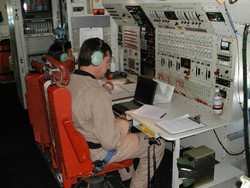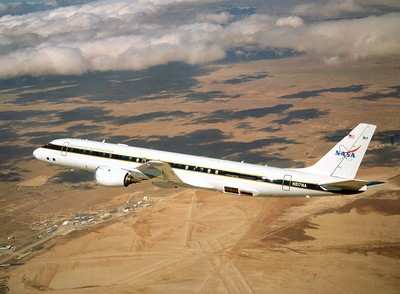DC-8 Flying Lab Takes To Alaska Skies
NASA's DC-8 flying laboratory departed the NASA Dryden Aircraft
Operations Facility in Palmdale, CA Tuesday for Fairbanks, AK to
participate in one of the largest international atmospheric studies
ever attempted.

The recent decline of sea ice is one indication the Arctic is
undergoing significant environmental changes related to climate
warming. NASA and its partners plan to investigate the atmosphere's
role in this climate-sensitive region during the Arctic Research of
the Composition of the Troposphere from Aircraft and Satellites
(ARCTAS) field campaign.
The extensive field campaign will investigate the chemistry of
the Arctic's lower atmosphere to help scientists identify how air
pollution contributes to climate changes in the Arctic. Of
particular interest is the formation of the springtime "arctic
haze." The return of sunlight to the Arctic in the spring fuels
chemical reactions of pollutants that have accumulated over the
winter after traveling long distances from lower latitudes.
"It's important that we go to the Arctic to understand the
atmospheric contribution to warming in a place that's rapidly
changing," added Jim Crawford, manager of the Tropospheric
Chemistry Program at NASA Headquarters in Washington. "We are in a
position to provide the most complete characterization to date for
a region that is seldom observed but critical to understanding
climate change."
 In addition to DC-8 airborne
laboratory from NASA Dryden, two other NASA aircraft, a P-3 Orion
from Wallops Flight Facility and a Beechcraft King Air 200 from
Langley Research Center, will serve as airborne laboratories for
the next three weeks, carrying instruments to measure solar
radiation and air pollution gases and aerosols.
In addition to DC-8 airborne
laboratory from NASA Dryden, two other NASA aircraft, a P-3 Orion
from Wallops Flight Facility and a Beechcraft King Air 200 from
Langley Research Center, will serve as airborne laboratories for
the next three weeks, carrying instruments to measure solar
radiation and air pollution gases and aerosols.
The DC-8 is equipped with a suite of 22 instruments designed to
collect atmospheric data while flying in the Arctic regions during
April and July. Researchers from around the world were selected to
participate and bring complex sensing equipment, as well as
expertise, to the campaign. Flight plans will be coordinated with
orbiting satellites and other aircraft and modified en route as
meteorological conditions develop to optimize scientific value.
"The DC-8 is unique in its ability to accommodate such a large
science payload, capable of measuring more than 40 chemical
constituents and aerosols, in a shirt-sleeve laboratory
environment, while traversing air masses of continental scale,"
said Robert Curry, director of NASA Dryden's Science Mission
Directorate. "Investigators will have direct access to their
instruments in flight and can collaborate with each other and
science teams on the ground as results are obtained."
ARCTAS is NASA's contribution to an international series of
Arctic field experiments that is part of the International Polar
Year. The National Oceanic and Atmospheric Administration and the
Department of Energy also are sponsoring research flights from
Fairbanks this month in collaboration with NASA.

"The Arctic is a poster child of global change and we don't
understand the processes that are driving that rapid change," said
Daniel Jacob, an ARCTAS project scientist at Harvard University,
Cambridge, MA. "We need to understand it better and that's why
we're going."
The wealth of data collected also will improve computer models
used to study global atmospheric chemistry and climate. This
ultimately will provide scientists with a better idea of how
pollutants are transported to and around the Arctic and their
impact on the environment and climate.
 "We haven't looked at pollution
transport in a comprehensive fashion," said Hanwant Singh, an
ARCTAS project scientist at NASA Ames Research Center, Moffett
Field, CA. "We can see Arctic haze coming in but we don't know its
composition or how it got there. One goal of ARCTAS is to provide a
comprehensive understanding of the aerosol composition, chemistry
and climate effects in the Arctic region."
"We haven't looked at pollution
transport in a comprehensive fashion," said Hanwant Singh, an
ARCTAS project scientist at NASA Ames Research Center, Moffett
Field, CA. "We can see Arctic haze coming in but we don't know its
composition or how it got there. One goal of ARCTAS is to provide a
comprehensive understanding of the aerosol composition, chemistry
and climate effects in the Arctic region."
The new aircraft observations also will help researchers
interpret data from NASA satellites orbiting over the Arctic, such
as Aura, Terra, and Cloud-Aerosol Lidar and Infrared Pathfinder
Satellite Observation, or CALIPSO. Interpreting satellite data can
be difficult in the Arctic because of extensive cloud cover, bright
reflective surfaces from snow and ice, and cold surface
temperatures. The new airborne view of the Arctic atmosphere
combined with satellite data will provide scientists with a better
understanding of the atmospheric side of the climate question.
A second phase of the ARCTAS campaign takes place this summer
from Cold Lake in Alberta, Canada, where flights will focus on
measurements of emissions from forest fires. Researchers want to
know how the impact of naturally occurring fires in the region
compares to the pollution associated with human activity at lower
latitudes. Understanding the relative influence of each is
important to predictions of the Arctic's future climate.
 ANN's Daily Aero-Linx (04.13.24)
ANN's Daily Aero-Linx (04.13.24) ANN's Daily Aero-Term (04.13.24): Beyond Visual Line Of Sight (BVLOS)
ANN's Daily Aero-Term (04.13.24): Beyond Visual Line Of Sight (BVLOS) Airborne 04.09.24: SnF24!, Piper-DeltaHawk!, Fisher Update, Junkers
Airborne 04.09.24: SnF24!, Piper-DeltaHawk!, Fisher Update, Junkers Aero-News: Quote of the Day (04.14.24)
Aero-News: Quote of the Day (04.14.24) ANN's Daily Aero-Term (04.14.24): Maximum Authorized Altitude
ANN's Daily Aero-Term (04.14.24): Maximum Authorized Altitude






